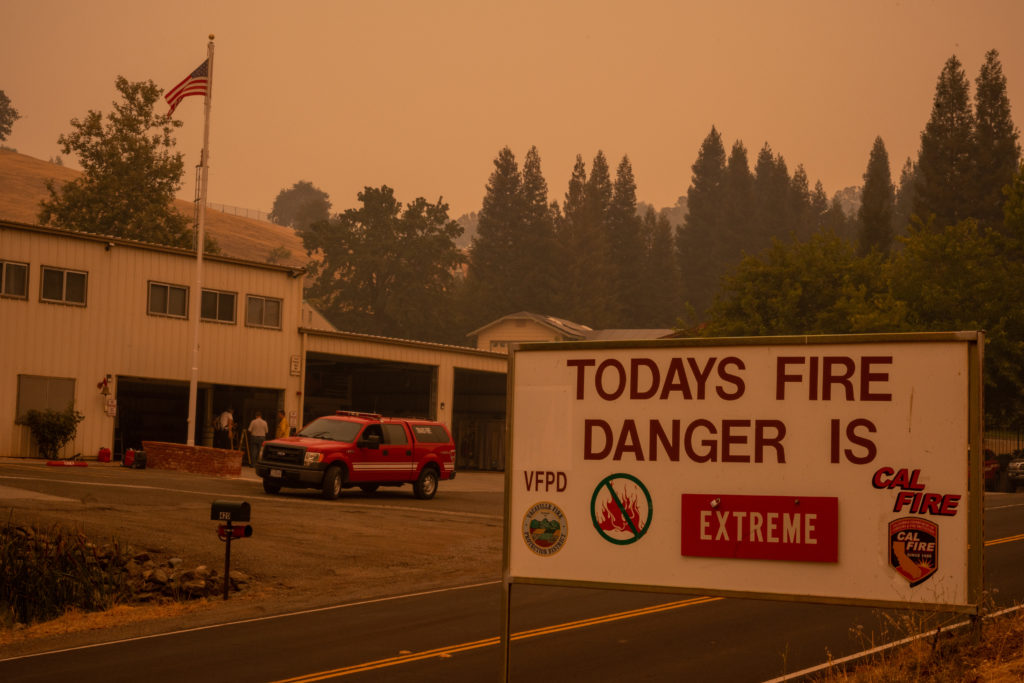When a wildfire is close, the best thing you can do is gather your family, pets, and go-bag and get out. But how long does that take? And how do you know when it’s time to go? With much of California still burning after last week’s lightning storms, CalFire’s fire tracker says over 1 million acres have burned so far. Many Californians are facing choices about when to evacuate, where to go, and what to bring along.
Over the weekend, I spoke via Zoom with Ralph McLaughlin, a native Californian who moved to Groveland full-time a few weeks ago. The Moc Fire, which as of this morning is still just 20% contained, forced McLaughlin and his wife to evacuate their home on Thursday.
“Growing up near fires and around them, this was the first time that I ever had to evacuate,” McLaughlin said. “We were relatively prepared, I’d like to think. Even then, it did take quite a bit longer to get our things — not just to get our things and go through the inventory, but also getting them into the car, getting them on the roof rack.”
McLaughlin learned some preparedness lessons on Thursday that he’ll take with him for the rest of the wildfire season and into future fires. Here’s what you need to know:
- Have a plan. “Even if there isn’t a fire nearby or a hurricane or a natural disaster, have a plan,” said McLaughlin. “If you have to leave your home, which no one wants to do, have a plan and know where you’re going to go.” Then, be ready to revise your plan.
- Make sure you can get information in a crisis. “Without information it’s hard to amend your plan — and hard to stick to your plan,” McLaughlin said.
- Have your important items packed and ready. “It’s not just, ‘Make sure you have the things you need.’ Make sure you can get those things together quickly and can pack them up quickly. It will probably take longer than you would expect,” he said.
Have a plan — and amend it if you have to
McLaughlin and his wife were monitoring the wildfires last week, so they knew they might have to evacuate their Groveland home. They even had a plan for where they’d go when the evacuation order came: either they’d go west on the main roads toward a town or east over the Sierras into Nevada. The fire came on faster than McLaughlin’s family thought it would, however, and they had to change their plan.
“We were aware of the smoke,” McLaughlin said. “We were aware of it. But that particular day, we had no idea even as of 2 p.m. that we were going to have to evacuate.”
He and his wife looked online and saw that a community just down the road from them was being evacuated. So they started packing the car, figuring they’d evacuate on Friday. Then the power went out.
I’m an outdoorsman and keep my kit nearby our vehicles, but even then it took me a good hour to get the car packed up. Spare marine/rv batteries and five gallon fuel cans feel extremely heavy when you’re in a rush. Line for the gas station 20 miles up the road was 20 cars deep.
— Ralph B. McLaughlin (@HousingRalph) August 21, 2020
“We were getting things together and then at 5:30 we saw an official evacuation warning,” McLaughlin said. “That’s when we decided we were going to leave. We weren’t going to wait for a mandate.”
They quickly nixed their plan A — to go west on main roads toward town — since the fires were coming from that direction. Instead, they drove east over the Sierras.
Emergency situations like wildfires are unpredictable. McLaughlin said it was very important to have multiple plans and change direction when one of those plans didn’t work out.
Make sure you have reliable communication
When the power went out at McLaughlin’s house, he lost contact with the outside world. Luckily, he had a wireless hotspot on hand. He bought it in March when a snowstorm wiped out power. So he quickly powered up that hotspot and got the official evacuation warning. “That was a critical thing for us,” McLaughlin said of his hotspot.
“We take for granted, especially someone like myself who grew up in an urban area, that we can get in touch with people,” he said. “But that’s not always the case in rural areas.”
Groveland is a mix of full-time residents, weekenders, and out-of-towners in rental cabins. “There very well could have been people up there on vacation for the first time,” McLaughlin said. “They could have been caught off guard.”
His experience is a good reminder that back-up lines of communication are essential parts of emergency preparedness. Whether a ham radio, a hotspot, or another device, it’s better to have extra communication tools on hand than it is to end up in the dark in an unfamiliar place.
Have your important items packed and ready
One of McLaughlin’s most important lessons from last week’s evacuation was that it took way longer to pack up his emergency equipment than he thought it would. Next time, he wants to make sure he has a bug out bag ready to go. And it’ll have things that are actually essential for evacuating safely. Before the evacuation, McLaughlin thought he could use a spare marine RV battery in an emergency. But it turned out to be way too heavy to get on the roof of his car, and he worried it would slow him down.
Now, he has his priorities straight. “When I get back, I will keep all of those things together,” he said. “I’m probably going to go overkill and have a go-box ready to go. If I’m going to have to go sit out in the wilderness and camp, I want it to be as close to glamping as I can.”
So instead of that spare battery, McLaughlin might invest in a really good cooler. He wants to be able to use up his perishable food before diving into canned goods or dry goods.
The bottom line
Most of all, McLaughlin wants others to learn from his experience and be prepared for disaster before they’re surrounded by smoke. The wildfires in California are still raging, and many more people will need to evacuate in the coming days. And in Texas and Louisiana, residents are preparing for another hurricane this week. Some Louisiana areas are now facing evacuation orders.
Do you have advice for evacuees or experience to share? Join the conversation in our forum.


You are reporting the comment """ by on